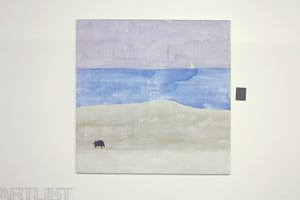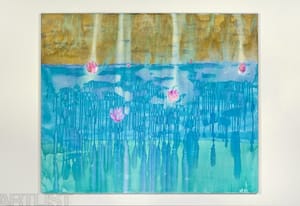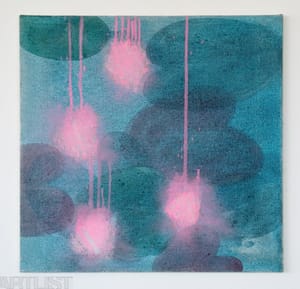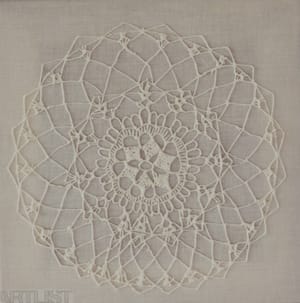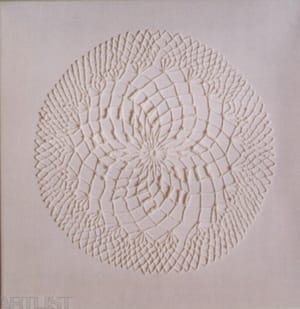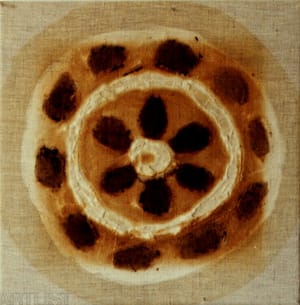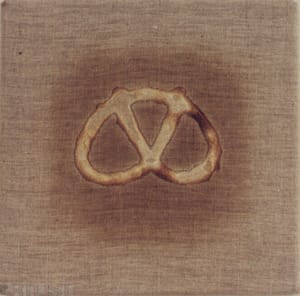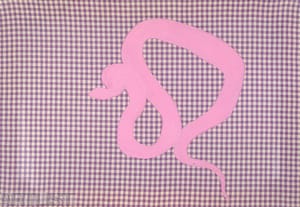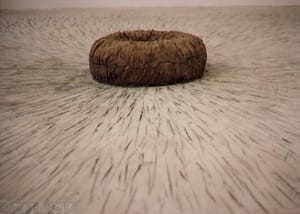- First Name
- Jitka
- Surname
- Géringová
- Born
- 1969
- Birth place
- Slaný
- Place of work
- Ústí nad Labem
- Keywords
- CSU Library
- ↳ Find in the catalogue
About artist
Jitka Géringová is mainly involved in drawing and painting. However, she does not use traditional materials like paper and canvas, nor does she use conventional colour schemes. As well as classical techniques the artist draws using icing sugar on practical household textiles (tablecloths, tea towels, handkerchiefs, etc.), on a gingerbread heart from a fair, and paints dough onto textiles and creates “baked images”.
Géringová started working with the theme of “culinary studies” in the early 1990s. Her interest in revaluating food technology, including rolling, slicing and kneading dough, is linked with her endeavour to express visually the problematic of women’s role in society and to initiate a discussion on female identity. The dough that she uses is now a semantically neutral material but makes reference to the problems of a socially constructed gender identity. Géringová deliberately uses a specific linguistic code of the domestic female sphere that she links with the public projection of female character traits (Pečené srdce / Baked Heart, 1999) or with banal impersonal statements made by anonymous spokespersons of both genders: “You don't regret last night, do you?” (Harlequin, 2000). She creates a banal environment by borrowing from the publisher of romantic books for women. However, Géringová’s work does not have to be seen only through the lens of gender. It is free of an explosively activist tension and is more the work of an individual conducting her own research, be this into gender or other forms of determinism. The subversive character of the interrogation of determinism in her works has more the character of a non-obligatory game. As well as motifs taken from the private sphere of the household, we also find iconic symbols from mythology and religion (e.g. Had na utěrce, The Snake on the Dishcloth 1996). These symbols lend Géringová’s work the archetypal level of ancient ritual. She expands the definition of gender and its identities to take in a timeless spiritual dimension. This is how the kitchen as a physical-mental space does not lose its sacred aspect.
At the start of her career Géringová did not experiment only with food technology and materials. She also examined the expressive dynamic and content of physical gesture. The creative component of her work is accompanied by a powerfully emotional, delicate dimension of the artist’s physical existence. The artefact Znamení / Sign (1994) evokes a disturbing feeling of physical threat. The artist delimits the surrounding space and that of her own body. Composed of a circle of earth the artefact represents a magical centre from which sharp lines project out on the floor of the gallery. This work contains a powerful message at a time when the sacred side of life is being pushed into the background. The sketches on the floor of the gallery are intended to show that the sacred can only appear in a completely concrete cohabitated point in time and space. Since 1994 Jitka Géringová has been involved in a reworking of the famous cycle of Water Lilies by Monet. The oldest in the series, an oil painting on paper, has an unpretentious gestural quality. It functions mainly as a record of the passing moment, a condensation of Bergson’s fluid “flow of consciousness”. The first variation on Water Lilies retains the value of symbol and gesture pointing to the psycho-physical reality of the artist’s physicality. The gestural character of the record highlights the connection between spontaneous processes in nature and the human organism. There is a pathos induced by the artist’s utilisation of the existential motif of the state of the modern subject in the world.
In her work since the turn of the millennium Géringová has been seeking the expressive potential of the form of water lilies and their leaves and flowers. Her working of natural phenomena (e.g. the cycle Les / Forest, 2010) possesses a strong spiritual charge. The works of this period are fascinating for their surface arrangements. The leaves of the lilies are oval and highly schematised. Géringová either places them within a broader scenic framework, and so we see them spread out over the surface of the water, or makes them part of a lyrically internalised gesture so that they evoke the vertical flights of glittering comets. The most recent of these works are distinctive for their apertures, bulges and a kind of reservoir comprising an imaginary arc of plants. They are symbolic of a productive force, since the lilies are linked with an aquatic environment that, according to M. Eliade, has a purely religious value, representing the element of the indistinguishability and virtuality of things. Water is also linked with the fecundity of Mother Earth and the female element in general. During this creative period Géringová combines glaze painting with pearl effects applied to the surface of images. She also draws on templates, using which she fills up her theme with the forms of various animals. Using these techniques and the trickling and dropping of colours she interrogates the unified code of representation and opens up questions relating to the basis of the image, the reasons for its aesthetic effect, its openness to inspirational sources from many different spheres, its ability to disentangle the web of an endless number of stories and to arrest the flow of the dominant narrative.
Géringová’s most recent work has been more playful, freer of anthropocentrism than her earlier work. Perhaps this is proof of an innocent play with tradition and the icons of art history, since anyone who can transform Monet’s water lillies into baked pictures is not lacking in a sense of humour.
- Author of the annotation
- Šárka Slaninová / Jírová
- Published
- 2012
CV
Studies:
2000-2006 doktorské studium Teorie výtvarné výchovy
1994-1996 postgraduální studium VŠUP Praha.
Ateliér prostorové tvorby textilu a alternativních technik, prof. Adéla Matasová
1988-1994 studies fine arts at the PF UJEP Ústí nad Labem
Exhibitions
- Solo exhibitions
-
2008 Česká Lípa, Galerie Jídelna, „Společné rysy“. Spolu s Janem Řezáčem. 3.10.-9.11.2008
2008 Hradec Králové, Galerie AMB, „Obrazy“ 14.2.-14.3.
2003 Česká Lípa, Galerie Jídelna, „Znaky“
2002 Opava, Dům Umění, „Upečeno“
- Group exhibitions not included in ARTLIST.
-
2011
Paralelní historie. Severočeská galerie výtvarného umění v Litoměřicích. 7.10.-20.11.2011
2010
Nikdy jsem tam nebyla. Ústí nad Labem, Galerie Emila Filly. 4.8.-1.9.2010
2009
Brno, Dům umění města Brna, „Formáty transformace“. 17.11.-2009 – 14.01.2010
Ústí nad Labem, Galerie Armaturka. „Velmi křehké vztahy. Obraz rodiny v současném umění.“ 28.4.-28.5.2009
2008
Řehlovice, Kulturní centrum Řehlovice. Mezinárodní výstava „Paměť umění – Gedächtnis der Kunst“. 27.7.
Ústí nad Labem, Galerie Na chodbě, „Jemně perlivá“ 15.10. – 11.11.2008
2005
Hodonín, Galerie výtvarného umění v Hodoníně, Folklorismy v Českém výtvarném umění XX.století
Uherský Brod, Muzeum Jana Amose Komenského, Folklorismy v Českém výtvarném umění XX.století
Zlín, IV. Státní galerie Zlín. Nový zlínský salon. srpen-září 2005
Plzeň, Galerie města Plzně, „Širší proud“. 11.9.-9.10.2005
2004
Praha, České muzeum výtvarných umění v Praze, Folklorismy v Českém výtvarném umění XX.století
Cheb, Galerie výtvarného umění v Chebu, Folklorismy v Českém výtvarném umění XX.století
2003
Praha, NG Veletržní Palác, Nejmladší
2002
Zlín, III. Nový zlínský salon
Monography
- Articles
GÉRINGOVÁ, J. Pomáhající profese. Tvořivé zacházení s odvrácenou stranou. Praha: Triton, 2011. Vyd.1. ISBN 978-80-7387-394-3
